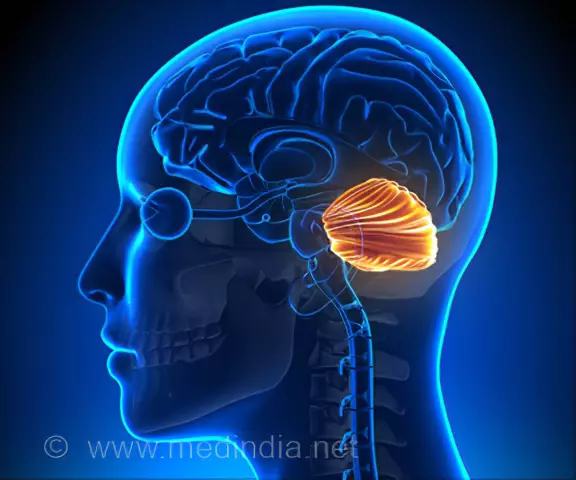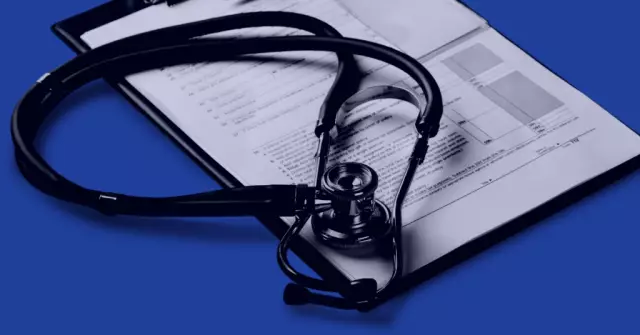- Author Rachel Wainwright [email protected].
- Public 2023-12-15 07:39.
- Last modified 2025-11-02 20:14.
Ataxia
Ataxia is a neuromuscular motor disorder characterized by impaired coordination of movements, as well as loss of balance, both at rest and when walking. Inconsistency in the actions of different muscles can occur as a result of lesions of certain areas of the brain or vestibular apparatus, which is sometimes due to a genetic predisposition. Treatment of ataxia and the prognosis of its development depend on the cause of the disease.
Types of ataxia

In clinical practice, the following types of ataxia are distinguished:
- Sensitive;
- Vestibular;
- Cortical or frontal;
- Cerebellar.
With sensitive ataxia, deep sensitivity fibers are disturbed, which carry information about the features of the surrounding space and the position of the body in it. The cause can be damage to the posterior columns of the spinal cord, thalamus or spinal nerves, as well as polyneuropathy and vitamin B12 deficiency.
On examination, the following symptoms of sensitive ataxia are revealed:
- Dependence of coordination on visual control;
- Violation of vibration and joint-muscle sensitivity;
- Loss of balance with closed eyes in the Romberg position;
- Loss or decreased tendon reflexes;
- Unstable gait.
A characteristic feature of sensitive ataxia is the sensation of walking on carpet or cotton wool. In order to compensate for movement disorders, patients constantly look under their feet, and also raise and strongly bend their legs at the knee and hip joints, and then forcefully lower them to the floor with their entire sole.
With vestibular ataxia, dysfunction of the vestibular apparatus leads to specific gait disturbances, systemic dizziness, nausea and vomiting. All symptoms are aggravated by sharp turns of the head and changes in body position. Hearing impairment and horizontal nystagmus - involuntary movements of the eyeballs - are possible. This type of disease can lead to stem encephalitis, ear diseases, tumors of the ventricles of the brain and Meniere's syndrome.
Cortical ataxia is caused by disturbances in the work of the frontal lobe of the brain as a result of dysfunction of the frontocerebellar system. The reason may lie in abnormal cerebral circulation, tumors or abscesses.
Frontal ataxia occurs on the side of the body opposite the affected hemisphere. Instability, tilting or heaving begins at turns, and with severe injuries, patients are generally unable to stand and walk. This coordination disorder is also characterized by disturbances of smell, changes in the psyche and a pronounced grasping reflex.
Features of cerebellar ataxia are loss of fluidity of speech, tremors of various types, muscle hypotonia, and oculomotor dysfunction. The gait also has characteristic signs: patients spread their legs wide and swing from side to side. In the Romberg position, extreme instability is observed, a fall back often occurs. Severe impairment of coordination of movements occurs during tandem walking, when the heel of one leg is attached to the toe of the other. Cerebellar ataxia can be caused by a wide range of diseases - from vitamin deficiency and drug intoxication to a malignant tumor.
Hereditary degenerative changes in the cerebellum cause spinocerebellar ataxias - chronic diseases of a progressive nature, which are dominant or recessive.
The autosomal dominant cerebellar form of the disease is often accompanied by the following symptoms:
- Tremor;
- Hyperreflexia;
- Amyotrophy;
- Ophthalmoplegia;
- Pelvic disorders.
The pathological sign of Pierre Marie's ataxia is cerebellar hypoplasia, less often - atrophy of the inferior olives and pons. The first gait disturbances begin, on average, at 35 years of age. Subsequently, violations of facial expressions and speech are added. Mental disorders are manifested in the form of depression, decreased intelligence.
Autosomal recessive spinocerebellar ataxia is combined with the following symptoms:
- Areflexia;
- Dysarthria;
- Hypertonicity of muscles;
- Scoliosis;
- Cardiomyopathy;
- Diabetes mellitus.
Friedreich's familial ataxia occurs due to damage to the spinal systems, most often as a result of family marriage. The main pathological symptom is the growing degeneration of the posterior and lateral columns of the spinal cord. At about 15 years of age, unsteadiness when walking and frequent falls appear. Over time, changes in the skeleton lead to a tendency to frequent joint dislocations and kyphoscoliosis. The heart suffers - the atrial teeth are deformed, the heart rhythm is disturbed. After any physical exertion, shortness of breath and paroxysmal pain in the heart begins.
Diagnosing and treating ataxia

With cerebellar ataxia, the following studies are performed:
- EEG. Reveals the reduction of the alpha rhythm and diffuse delta and theta activity;
- MRI. Carried out to detect atrophy of the brainstem and spinal cord;
- Electromyography. Shows axonal-demyelinating damage to peripheral nerve fibers;
- Laboratory tests. Allows you to observe the violation of amino acid metabolism;
- DNA test. Establishes a genetic predisposition to ataxia.
Treatment for ataxia is aimed at relieving symptoms. It is carried out by a neurologist and includes:
- General strengthening therapy - anticholinesterase agents, cerebrolysin, ATP, B vitamins;
- Exercise therapy complex - strengthening muscles and reducing discoordination.
In the treatment of spinocerebellar ataxia, a course of immunoglobulin may be required to correct immunodeficiency, while any radiation is contraindicated. Sometimes succinic acid, riboflavin, vitamin E, and other medications are prescribed to maintain mitochondrial function.
The prognosis of hereditary ataxias is poor. The ability to work, as a rule, decreases, and mental disorders progress.
YouTube video related to the article:
The information is generalized and provided for informational purposes only. At the first sign of illness, see your doctor. Self-medication is hazardous to health!






